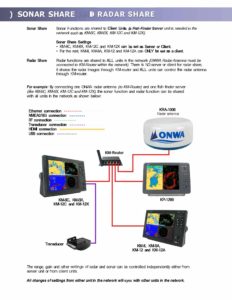NMEA OneNet – what’s that?
NMEA One Net is the new NMEA protocol that Onwa have installed into their latest KM series plotters. It’s an IP (Internet Protocol) system – similar to the way that we send data and information over the ethernet, so it isn’t exactly a brand-new invention but rather a development of one that has been around for a good while. NMEA OneNet is designed for the exchange of data and other information between electronic devices for use on boats. OneNet provides a system that will allow devices using this new technology to talk to each other at data rates up to 10Mbits/second over a twisted pair connection. This is quite a step up from NMEA2000 which is 250Kbits/second. When NMEA200 first appeared on plotters etc it was welcomed as a faster plug and play connection system both in terms of data transfer speed and when adding a new NMEA device to an existing system. Of course, this required first the installation of an NMEA 2000 backbone – itself requiring some cost and time to install. The old faithful NMEA0183, whilst capable and able to transfer data at a rate sufficient for the needs of most boat interconnections in the past, was nevertheless always subject to the occasional head scratching moment when connecting two devices together. NMEA2000 fixed that and it has been the must have data transfer system for boats until now. Today we need fast, fast connections to transfer all the gizmos now available on boats and OneNet is that system – able to transfer more than just data, video for example. For most of us on leisure boats this will be the great advantage of OneNet – that it can be used to transfer radar, sonar screen and video etc around the boat by just plugging in an RJ45 (network) plug and nothing more. For commercial users there are other benefits, vastly complex networks with a great many users and devices all linked at very high speed will be what they are looking for.
With the adoption of NMEA OneNet fully into Onwa products beginning with the new KM series (1299 series are also capable via an RJ45 to USB connection) brings a whole new exciting way of creating a system where multiple devices are simply plugged into a router to connect everything together. Onwa call it Sonar Share ,
Here is an example of the way that it works:
Essentially any one device can send its data to any other via the network. You could have, for example, a KM12X (on the left of the diagram) which has AIS and sounder built in sending the AIS and Sonar data to other less expensive KM models that don’t have these extras installed and become an independent clone of the KMX. An Onwa radar antenna on the same network can also send its data and be controlled by any of the plotters on the network as both KM and KP1299 model plotters have the different screens and controls already built in. Some devices, such as a Sonar Transducer, will still be NMEA 0183 but that can be connected to the KM12X via the 0183 data connection and that information will be converted to OneNet within the plotter and sent to all other devices. Really useful is that whilst this sharing is going on in the background any of the devices on the network can switch around their respective screens without any effect upon the others. e.g. A radar equipped plotter can send its radar information to other devices, they can view and adjust the radar antenna whilst the original host plotter has switched to an entirely different function.
So, why OneNet? A comment we sometimes hear is that NMEA2000 does everything so why change. Well no reason if you have a boat full of NMEA 2000 equipment and everything works together. Same with NMEA0183 which, despite the views of some folks, works well when connected together with other 0183 devices. However, when it comes to upgrading, then that is the time to think of the way that technology is moving forward with ever faster systems, unfortunately N2K has hit its limit. Consider the respective bandwidths, NMEA2000 = 256KB/sec, OneNet, up to 10 Gbits/sec (up to 40,000 times faster). You cannot send Radar, video or a sonar screen as a data feed using NMEA2000 – at 256K bandwidth it just isn’t possible. A similar limitation was evident in the early days of the internet when we used dial up at 56K on a good day, who of us would choose to stay with dial up when high speed internet is available.

AVES Marine are selling these systems now, for more information send an enquiry using the message form on this website or email us at sales@avesmarine.com. If you prefer the traditional and better method of a phone call, you can always speak to me, Alan, by calling 01357 680054 or 07930 127512.
Promise….. no on hold for thirty minutes listening to horrible distorted music and how important your call is. If I can’t pick up immediately leave me a message and I will call you right back as soon as I am free.
Alan
Click to see OneNet connectivity on KM models


